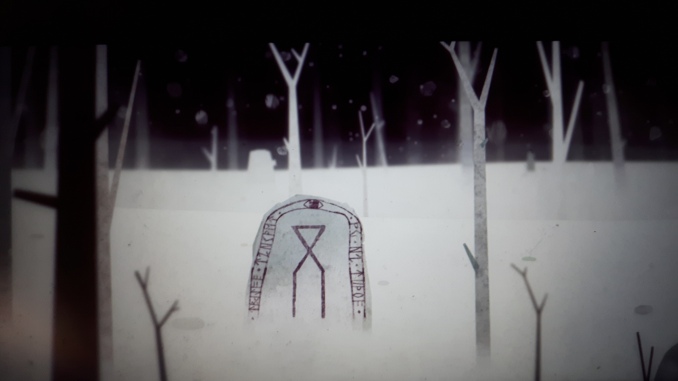
The setting of Year Walk is a very quiet Swedish forest: snow, birches, the occasional cottage. And a couple of runestones. This game is developed in Sweden and based on Swedish folklore, and you can feel that in the atmosphere of the game. It’s probably no coincidence that the runestones are among the closest I’ve seen in a game to what an actual Viking Age runestone looks like: standing stones with runes running in a band along the edge and all carved lines filled in with dark red (which is the standard in Sweden, but not Denmark or Norway). The similarities do end there, though. These runestones are part of a puzzle, and it’s the lines in the middle that’s the point, not the runes. On a real Swedish runestone, that space would normally be occupied by some kind of decoration: a cross, most likely, or an animal form. The runic band is normally in the form of a snake. But you can probably see the resemblance:

The runes on the Year Walk stones aren’t all proper runes, either.

They seem to be the same on all stones, and transliterate (from the older futhark) as:
* tbþï– * tï{N}sþet * þ{G} * {N}ï * tuþ{O}- *
This transliteration needs a couple of comments.
- The runes transliterated as ï are an interesting case; that rune is rarely found outside of futhark inscriptions (that is, inscriptions that comprise the entire futhark) and its sound value is unclear. It’s most likely a vowel. (It appears on one of my favourite runestones, which can’t be/hasn’t been interpreted.)
- Using { } means that the letter(s) between them is interpreted as being from the Latin alphabet. Here’s another wonderful runestone that has Latin characters on it as well as runes.
- The transliteration – indicates a character that can’t be defined but can be counted as a rune. These are, if anything, so-called pentimal runes, mostly known for being on the 19th century Kensington runestone and in the somehow related Larsson papers (and that is very much a discussion for another time). In that case, they could transliterate as 23 and 2.
Of course, that’s a long description for a piece of runic writing that is probably not meant to be understood linguistically. I find it interesting that the developers/designers decided to just write some rune-like characters and not attempt to give it meaning.
Bonus reading: if you’re interested in non-lexical runestones, ciphers, and how a runestone is designed – and you read Swedish – I highly recommend Marco Bianchi’s dissertation on the subject. I’ll probably return to Kensington and other American runestones at some point, but until then, here’s a good article on the subject.
